I'm trying to implement functions from bayesplot package on a INLA object and a little unsure of how to draw from the posterior predictive distribution. I think I almost have it but rstan draws are more variable than the INLA ones.
In rstan, using the simplified example from bayesplot vignette I can:
library(bayesplot)
library(ggplot2)
library(rstanarm)
library(ggpubr)
library(tidyverse)
#rstan model set up
roaches$roach100 <- roaches$roach1 / 100 # pre-treatment number of roaches (in 100s)
fit_poisson <- stan_glm(y ~ roach100 + treatment + senior, offset = log(exposure2), family = poisson(link = "log"), data = roaches, seed = 1111, refresh = 0)
#In order to use the PPC functions from the bayesplot package we need a vector y of outcome values:
y <- roaches$y
#and a matrix yrep of draws from the posterior predictive distribution,
yrep_poisson <- posterior_predict(fit_poisson, draws = 500)
#then plot:
p1 <- bayesplot::ppc_dens_overlay(y, yrep_poisson[1:50, ])
p1
I want to replicate that plot on a INLA object. According to the bayesplot vignette you can do this as they have provided code to define a simple pp_check method that creates fitted model objects of class e.g. foo:
pp_check.foo <- function(object, type = c("multiple", "overlaid"), ...) {
type <- match.arg(type)
y <- object[["y"]]
yrep <- object[["yrep"]]
stopifnot(nrow(yrep) >= 50)
samp <- sample(nrow(yrep), size = ifelse(type == "overlaid", 50, 5))
yrep <- yrep[samp, ]
if (type == "overlaid") {
ppc_dens_overlay(y, yrep, ...)
} else {
ppc_hist(y, yrep, ...)
}
}
To use pp_check.foo we can just make a list with y and yrep components and give it class foo:
x <- list(y = rnorm(200), yrep = matrix(rnorm(1e5), nrow = 500, ncol = 200))
class(x) <- "foo"
#create plot above:
pp_check(x, type = "overlaid")
INLA
#create same model but in inla:
library(INLA)
fit_poisson_inla <- inla(y ~ roach100 + treatment + senior, offset = log(exposure2), data = roaches,
control.predictor = list(compute = T),
family = "poisson")
inla_object_name$marginals.fitted.values returns a posterior predictive distribution for each y:
fit_poisson_inla$marginals.fitted.values
#so to get distribution for first oberservation:
fitted.Predictor.1 <- fit_poisson_inla$marginals.fitted.values[[1]]
I think repeatedly sampling from this would give me what I need but there are only 75 values (dim(fitted.Predictor.1) per observation used to create this distribution when in reality I would want to be sampling from a full range of values. I think we can do this (section 4.3 here) by using inla.tmarginal using linear predictor:
fitted_dist <- fit_poisson_inla$marginals.linear.predictor
#should i have used "inla.rmarginal(n, marginal)"?
marginal_dist <- lapply(fitted_dist, function(y) inla.tmarginal(function(x) {exp(x)}, y)) %>% map(~ as.data.frame(.) %>% rename(., xx = x))
#resample 500 times
yrep_poisson_inla <- as.matrix(bind_rows(rerun(500, lapply(marginal_dist, function(x) sample(x$xx, 1)) %>% as.data.frame())))
#convert to class foo for pp_check
x <- list(y = y, yrep = yrep_poisson_inla[1:50, ])
class(x) <- "foo"
p2 <- pp_check(x, type = "overlaid")
#plot
ggarrange(p1, p2, ncol = 1, nrow = 2, labels = c("rstan", "inla sample"))
My question is how do I correctly get a matrix of draws from the posterior predictive distribution from this inla (fit_poisson_inla) object to pass into pp_check? yrep_poisson produces discrete values while yrep_poisson_inla produces continuous values. There is a lot more variation in the rstan draws than INLA (second plot). Is what I have done correct and this is just some sampling issue or is it an artifact of the different methods? In more complicated examples the differences could be substantial.
Thanks

